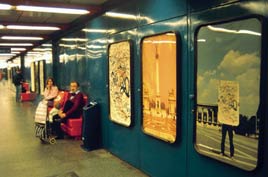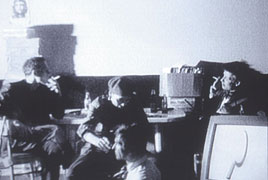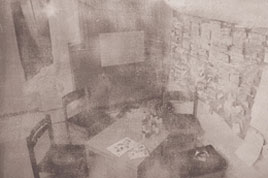|
|
|||||||||||||||||||||
THE ART OF SUBTRACTION
Miklos Erhardt & Joanne Richardson
Heraclitus once said you can't step in the same river twice. During the long march of history, we have been moving closer and closer to that river. It may even be possible to speculate that we are now standing in it …In "Eastern Europe," having escaped from the shackles of a rigidly established code-system, now we are able to live society from the inside. In other words, as artists, we have lost our archaic position of being independent. The communist regime was very likeable from the point of view that it never really wanted us to be involved. Although practical creativity was forbidden to us, we could always sustain the belief that we were more clever than the system.
Now the system, which has become even more deeply ideological than the old one, lures us to function as milk lures its bacteria to produce yogurt.
This is not a judgement either against the system or against the bacterium.The grand period in modern art began with a need for total, militant, and subversive participation. The defining feature of modernism was art's loss of faith in the system that produced and sheltered it. Artists used their energies to revolutionize this disappointment and began to chisel away at the fortress of art. As art deconstructed its own system of production, language became its most important feature. Visuality receeded into the background.
Today this revolutionary character has withered and split into a thousand fragments, and the visual arts are capable of producing only brute, inarticulate facts.
The history of contemporary art is like reading an inventory list. A recent exhibition in Paris bears witness to the overproduction of redundancy without purpose: dozens of telephone books, thousands of slides, a list of all artists with the name Martin, mineral water bottles, hundreds of dice, 100 portraits of 100 years, CD-rom installations, internet projections.
Something for everyone, and simultaneously for noone.Quantitatively, contemporary art is obese.
Participation still triumphs, but it is a transformed, functional and bacterial participation.
Artists participate in the system like bacteria thrown into milk: they agitate furiously, they produce secretions in large quantities, but by some automatic mechanism, instinctively and without thought.
The demand from artists for constant agitation and restless activity assures the real dissolution of movement - everything moves, like in a vacuum, with the same unbearable speed.In the "free" market system, the grant is the mechanism that allows artists to hold on to the archaic illusion of being independent. The grant is a product of the system's tolerance - it appears to be generated by the recognition that art can't be accounted for by the logic of the market, and that allowances have to be made for the survival of artists out of the philanthropic goodwill of patrons, governments and non-profit institutions.
In reality, the grant is the catalyst of the artist's so-called "maturation" process, so it's already a sub-category of the art market.The grant pays for surplus time. This is not Marx's surplus, in which the surplus hours of labor are stolen from the worker by capital. It is superfluous time, or what was once called leisure, though leisure is now so completely programmed that it is another form of compulsory work. The grant pays for time above work, for time that is not work, for time that is not time.
The grant does not purchase labor time, which can be measured quantitatively and exchanged for a wage. It pays for the production of a product (out of this superfluousness) that is beyond measure, ephemeral and speculative - the product is the artist, who is, in principle, not marketable. While seeming to be a form of money paid for nothing, a gift that is outside the circle of exchange, the grant buys the artist in the process of becoming-artist, in fragments so small that they seem almost to escape notice. To receive a grant, the language and the idea have to be "correct." Slowly, without notice, the foreign tongue begins to colonize our thoughts.
To assure the survival of the last social class - artists and intellectuals - grants play a formative role in the production of consciousness.
The last class now exists only in a virtual way, feeding on the fees of self-mystification extracted from the social body as a whole.
It refuses to believe in its own disappearance because it has a strong sense of importance based on the enormous documentation of its history - which we once called "culture."
Culture is dead, but intellectuals are always the last to hear the news.Our epoch is completely saturated with market-based activity: every aesthetic gesture and intellectual product is instantaneously out on the market.
In the 1960s the Situationists predicted that any product of art (any aesthetic object) which doesn't belong to situations will become part of the spectacle, thereby enriching the system. This was the root of the Situationists' aversion towards artists.
It has become the root of the system's ingenuity about how to exploit aesthetic objects, born codeless and to be wild.
The rhythm of market-based exploitation of artistic inventions has become so fast today, that during their career, artists are able to remarkably enrich the system - regardless of their intentions.Creativity, once the sacred right of god and artists according to romanticism, is now one of the fastest selling commodities. The last fortress of pathos in art has already fallen.
Corporations use the image of creativity embodied in the mythical figure of the artist as an advertisement for their own activity, as a model the consumer can identify with. Large multinationals sink millions of dollars into exhibitions and buy art works for their offices - as public relation strategies, to improve their image.
Art is already a corpse. Its radical energies vanished, it has become a useful detour for the money-laundering industry.
On the cleaned field of creativity the first colonists have arrived. Abandoned without purpose, we should leave.
Today under the imperative of "do it yourself," creation has become a duty demanded democratically of everyone.
"Go create" says the new slogan of Sony. On the 830th day a digital penguin takes the place of the apathetic observer. The apathetic observer stands in the wilderness and laughs. He sees that it is good.The order of production has become more artistic than art itself. And artists have become a subcategory of production.
The radical, active, and subversive participation demanded by the Situationists has not failed to contribute to the system it wanted to destroy. Participation, interactivity, even subversion are all oriented toward production, and any form of production can enrich a system whose only purpose is to push commodities on the market with increasing speed.
Even "revolutionary" ones.A road has opened instead for art to elaborate new forms which can't enrich the matrix. We can speculate that the small epoch of art has begun.
The grand objects of art produced during modernism, the creation of sublime theories which had an aerial perspective on totality, the "Big Man" as the embodiment of creative genius - all of these are vanishing moments.
Artists must learn to loose their character of being artists, and to give up their longing for the cult of creativity.


Abandoned to its own resources, art now stands on an arid, empty field where winds blow … in silence. In this new situation, more suitable is the vertically small dislocation, directed backwards. The vertically small dislocation is not marketable.Since market-culture is already able to create independently, henceforth the artist subtracts.
Subtractions are not phenomenological reductions, nor deconstructions.
Phenomenological reductions in art, as in philosophy, negate the inessential in order to reach the eidos. They are purifications that enrich the scope and function of their medium. Gabor Body once spoke of a "countdown process towards the original forms of consciousness and language."
This purification is a reductio ad absurdum - think of Kubelka abolishing motion as an illusion of cinema, and reducing film to the static image, or of minimalist art.
Purified, the medium expands without limitations, and achieves grotesque (dis)proportions. Minimalism can only become visible as the absolutely large, the mathematically sublime.
At a certain point of dissolution, absolute zero implodes and touches infinity.Deconstruction, as a negation, begins from the inside of phenomenology, but reaches different conclusions - the medium is always already impure.
Dada does not purify, it destroys. Destruction becomes a hoax, a scandal. It makes visible the humiliation of art, which can no longer bear the sorrow of having lost an integrity it never really had.
During the heroic age of the avant-gardes, destructions announced themselves loudly. They produced noise. They provoked media spectacles. They used the language of warfare. They were obtrusive interventions, visible cuts on the body of the medium.
Both reductions and deconstructions were structural experiments. Subtractions, on the contrary, are surface eliminations of phenomena, negative catalogues, inventories in reverse.In the Inside/Out project (signed by Dominic Hislop and Miklos Erhardt), the personality of the artists was subtracted from the work of art. This project was realized by Budapest homeless, who were given a photo camera so they could produce themselves as their own objects of observation. This subtraction should not be understood as a purification of the field of art.
Since the artist is proper to art, Inside/Out subtracted art from the work of art. It became just a work.
The Tequila Gang film followed the principle of the earlier project - a group of Budapest homeless were given a video camera to record themselves and produce their own film as a sequence of different fragments.
Here it was not just the personality of the artist that was subtracted, but also the artist's name. The work became just a nameless work.Subtractions are difficult to perceive. You need to look carefully to discover them.
The media have absorbed all spectacle. And the most radical formal experiments of the past have been captured by television ads and music videos. When the "experimental" is everywhere, it is nowhere.
Radicalism today can survive only as the abolition of radicalism - by becoming unobtrusive, miniscule, unseen, unheard.The art of subtraction will be imperceptible, a passageway, without past or future ...


Budapest, 2001.